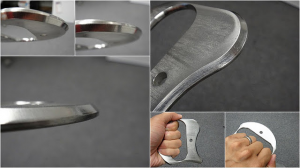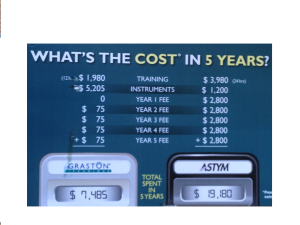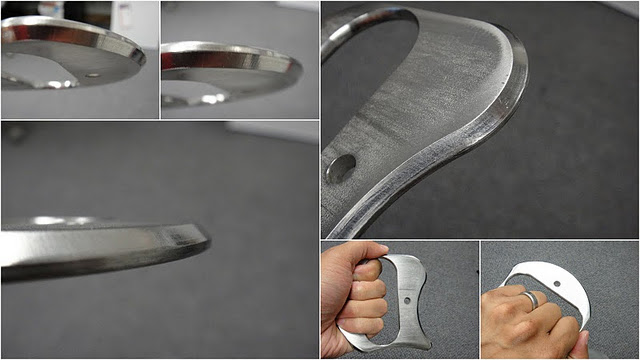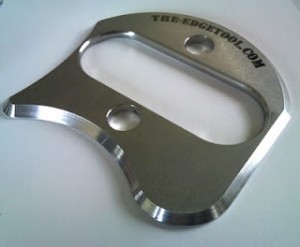
The EDGE Tool is designed to assist with manual treatments. It was designed and is sold by Dr. Erson Religioso III, DPT, FAAOMPT who blogs at The Manual Therapist. For those interested, the Edge can be bought at The Edge Store. Dr. E was gracious enough to let myself and the clinic I practice at demo the edge tool. Previously, here on PT Think Tank Tyler Shultz wrote briefly on Graston Technique (Registered Trademark) in his post Medieval Therapy Techniques?
Background
There are many “theories” and “schools of thought” regarding the use of instruments in manual therapy. In fact, there is a range of names for various techniques including, but definitely not limited to:
- ASTYM (Registered Trademark)
- Graston Technique (Registered Trademark)
- Augmented Soft Tissue Mobilization
- Instrumented Soft Tissue Mobilization
- Instrument Assisted Soft Tissue Mobilization
- Scraping the Skin with Instruments (STSI)
There is even Sound Assisted Soft Tissue Mobilization (SATSM)! Now, the point of this post is not to discuss in detail the proposed and potential mechanisms or treatment “targets,” but rather the product. What the heck is Graston, ASTYM, augmented or instrumented soft tissue mobilization anyway? Essentially, to me, these are all just fancy ways to say using an instrument to touch and treat your patients manually. For clarity’s sake, you can only say you are using some of the previously mentioned techniques if you are certified or take the courses

associated with them. To be blunt, I do not agree with many of the proposed theories that most are sold and utilized under. I think many of the websites contain false and misleading information. But, that is a different discussion, for a different time…
Other Tools
There are many other tools on the market to assist with the manual treatment of patients. For the most part, these tools are very expensive. Most are linked to the courses or schools of thought that sell them. Many, you must take their courses. Some, you have to RENT the tools.
The EDGE
The edge has a very intuitive design. It is easy to grasp and has various surfaces and contours for use. I find it useful in creating even, gentle pressure and stretch. I have even utilized it with movement. At first, I struggled to gauge how much pressure I was providing. But, like any manual treatment the response and feedback of the individual we are treating can be used as a guide. I probably use this tool differently than most. My applications have been mostly for gentle manual work. So far, I have used the edge on the foot, lower leg, arm, and neck with patients. I have practiced on the back, forearm, and rib region of colleagues. I have even used it and felt it on myself.. If utilized correctly I think the Edge can be used safely to deliver manual therapy. I think it is very easy to be too aggressive with such tools (especially given the context and theory many are sold under), but that can be easily avoided with judicious monitoring of patient response.
Overall, I was highly impressed with the Edge. It is extremely well designed and constructed. Maybe the most attractive aspects of Dr. E’s product is the price and availability. It is much cheaper than any of the other products on the market. And, you do not have to buy any overpriced courses to use it! But, like any tool we use whether it is our hands, an exercise, a piece of equipment, or our words it is only as good as the knowledge we utilize to implement it.
If you are going to use a tool to treat your patients, the EDGE is the most practical, the cheapest, and the best design. Dr. E is not selling mechanisms, courses, or a school of thought, but just a product. Luckily, you can buy the Edge Tool for whatever you want to use it for!
Do you use instruments for manual therapy in your clinic? What tools do you utilize? Have you taken courses? What are you thoughts on if, how, or why we should or should not use them?



I love the EDGE! Easy to use and I have seen benefit from it – sorry, no RCT’s to point to 🙂
Randomized control trials do not need to the basis of your entire practice!! But, your practice should be based on the philosophy of science including concepts of prior plausibility and strong logic. Thus, when RCT’s exist, are well designed, and in line with good logic we should absolutely implement their results within the broader context of physiology, basic science, and other published literature. However, RCT’s are tough in such a multi-modal profession such as physical therapy. In addition, RCT’s for the non-pharmacologic treatment of painful problems can be difficult to truly analyze given the effects of patient expectation, PT expectation, placebo response, and the difficulty in designing a realistic comparison group. True scientific “control” is difficulty, if not impossible. A study examining the effect of spinal manipulation on pressure pain thresholds/hypoalgesia in healthy volunteers is an interesting example of this: http://www.biomedcentral.com/1471-2474/9/19
I quote “A significant increase in pain perception occurred following SMT in the low back of participants receiving negative expectation suggesting a potential influence of expectation on SMT induced hypoalgesia in the body area to which the expectation is directed.”
If an RCT illustrated that craniosacral therapy was more effective than nothing (or “placebo”) in treating neck pain should we utilize craniosacral therapy in practice? NO, because the THEORY of application and assessment makes no sense. What does that hypothetical RCT REALLY tell us? That gently touching patients in pain and telling them a not true story may be beneficial. This post explains that concept in more detail: http://www.sciencebasedmedicine.org/index.php/of-sbm-and-ebm-redux-part-ii-is-it-a-good-idea-to-test-highly-implausible-health-claims/
So, where does that leave us? We must be guided by a strong understanding of logic, cognitive biases, and a DEEP model of the mechanisms of our client’s complaints (many times involves pain) as well as our techniques or approaches. Essentially, strong scientific, inquiring, SKEPTICAL minds. Jason Silvernail does an excellent job discussing some of these issues in his post EBP, Deep Models, and Scientific Reasoning over at the Evidence in Motion Blog: http://blog.myphysicaltherapyspace.com/2008/05/ebp-deep-models.html
Lastly, although not directly about physical therapy the blog Science Based Medicine has some fantastic resources and discussions surrounding this issue: http://www.sciencebasedmedicine.org/. I would suggest starting with: http://www.sciencebasedmedicine.org/index.php/about-science-based-medicine/
That post turned out longer than expected, and it is a little off topic, so my apologies.
From the little bit I’ve seen of the edge, it definitely seems to be a better value than many of its competitors. I mean after all, we’re all PTs here, do we really need a series of classes on how to use a device to perform STM?
In practice however, I very seldomly use anything but belts for distraction. I don’t do STM very often, as much of the work I do is focused on correction of movement faults and use of other manual techniques and corrections that may contribute to those faults. In other settings however, especially private practice where early on you often have to pay more attention to a patient’s symptomatic complaints, I can definitely see how a tool like the Edge would help maxmize the treatment, while saving your hands from wear.
Kyle,
Very well written review. I have also been using The Edge for a few months, and I like it so much that I became an affiliate. I never had much interest in taking all of the coursework (and paying all of the money) for those trademarked courses, so The Edge was a perfect fit for me. Like you, I use it fairly gently, often before or after other manual techniques. I agree that for the price, it is the best option out there for those who choose to do any sort of instrument assisted therapy.
Ann
Kyle,
Great review! I have minimal knowledge in soft tissue techniques and good to hear such positive comments on Erson’s tool. I hope to write one soon but very much a rookie in these techniques. I may just have to change gears a bit and do more soft tissue work.
I highly agree with your ‘bottom line’. It is reassuring that their are actually people out there to help you and not just make a buck!
Harrison
Kyle,
You never disappoint. Great post.
I use tools occassionally in the clinic and picked up a set of 3 for under $20 about a year ago. Took several weeks to come but was well worth the wait. Google or search for gua sha tools and look at the options.
I actually bought this a few months ago but have not had a chance to use it yet (sometimes I just forget or misplace new tools). I’ll have to dig it out and see if I can use it after reading this post.